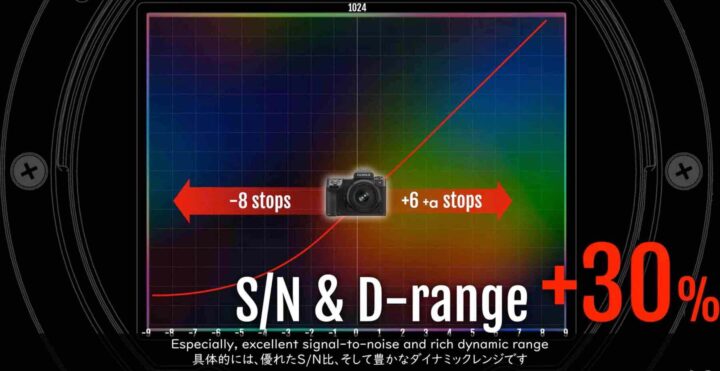Fujifilm GFX100 II: The Truth about ISO 80 and the 30% Increased Dynamic Range

ISO 80 and Dynamic Range
We have just covered the talk about the the new sensor of the Fujifilm GFX100II and the up to twice readout speed.
At the end of that article, when I listed the reasons why to get the GFX100II instead of the GFX100S, I wrote the GFX100II has 30% (or 1/3rd of a stop) better dynamic range.
And since I noticed this is another thing that some people struggled with, I decided to elaborate now more in depth.
After testing the dynamic range, Jim Kasson (linked below) agreed that yes, dynamic range is increased, but not by 30%. Jim says:
At ISO 80 those folks at Fujifilm have dropped all the data below the nominal black point, slicing off the left half of the histogram, and cutting the measured read noise in half of what it would normally be. […] You’ll still get slightly improved FWC — but I don’t measure the claimed 30% improvement — and decently low read noise. So it’s an improvement, but not a huge one.
Now, whatever Fujifilm does in terms of software, that has been measured by Jim and I won’t argue that. And it is true that this does make ISO80 dynamic range look crazy good.
But what Fujifilm at the end of the day said, is that there is a 30% dynamic range increase.
What does this mean?
Well, 30% expressed in stops means about 1/3rd of a stop improvement. As a reference, 1 stop increase means doubling the amount of light you let in on the sensor.
So the misunderstand is simple: if the GFX100S has let’s say 14 stops DR, it does not mean that Fujifilm claimed the GFX100II has 18 stops dynamic range (+30%), but 14,3 stops of DR (+1/3). And moreoever, in the X summit the 30% increase is mentioned in the video section of the summit, and Fujifilm has not been clear if it applies also to stills.
What I can say, is that 1/3 DR increase for stills what a Fujifilm rep told me personally during a Fujifilm event. He told me Fujifilm Italy made its own measurements once they got the camera from Japan, and at base ISO they noticed a 1/3 to 2/3 of a stop DR increase.
Now, why did Fujifilm say 30% instead of 1/3rd of a stop, even though they mean the same?
Well, I guess it just sounds better saying 30% rather than 1/3rd of a stop, but of course it can create confusion.
So yes, at base ISO the new Fujifilm GFX100II will give you the better dynamic range over the GFX100S. Also Jim confirms this. But not by a very large margin. Fujifilm says it is 1/3rd of a stop for video, and Fujifilm Italy told me they measured that too for stills.
- Fujifilm GFX100 II – New
BHphoto / Amazon / Adorama - GF 55mm f/1.7 R WR – New
BHphoto / Amazon / Adorama - GF 30mm f/5.6 Tilt Shift – New
BHphoto / Amazon / Adorama - GF 110mm f/5.6 Tilt Shift – New
BHphoto / Amazon / Adorama
Jim Kasson Articles:
- blog.kasson – How fast is the GFX 100 II electronic shutter?
- blog.kasson – More on GFX 100 II electronic shutter speeds
- blog.kasson – Fujifilm GFX 100 II EDR, read noise spectrum
- blog.kasson – Fujifilm GFX 100 II EDR, spectra, 16-bit precision
- blog.kasson – Fujifilm GFX 100 II EDR vs shutter speed
- blog.kasson – Fujifilm GFX 100 II: more on EDR vs shutter speed
- blog.kasson – GFX 100 II EDR, shutter speed in CL mode
- blog.kasson – GFX 100 II read noise in CH drive mode
- blog.kasson – GFX 100 II EDR summaryGFX 100 II EDR summary
- blog.kasson – Fujifilm GFX 100 II — a theory of the ISO 80 implementation
- blog.kasson – Fujifilm GFX 100 II — preparing for photon transfer curve testing
- blog.kasson – Fujifilm GFX 100 II EDR with and without LENR
- blog.kasson – Fujifilm GFX 100 II ISO setting vs gain
- blog.kasson – Fujifilm GFX 100 II — FWC, input referred RN, photon transfer curves
- blog.kasson – Fujifilm GFX 100 II — ISO 80 and 100 shadow noise, visuals
- blog.kasson – Fujifilm GFX 100 II — deep shadow noise at 14 and 16 bit precision
- blog.kasson – Fujifilm GFX 100 II — ISOlessness at low ISO settings
- blog.kasson – Fujifilm GFX 100 II — ISOlessness at high ISO settings
- blog.kasson – X2D, GFX 100 II base ISO visual shadow noise
- blog.kasson – GFX 100 II, X2D — blur and distortion with IBIS and ES
- blog.kasson – Fujifilm GFX 100 II precision in CH shutter mode
- blog.kasson – GFX 100 II shadow noise at ISO 80, SS and CH
- Jim’s commend about ISO80 at dpreview here

